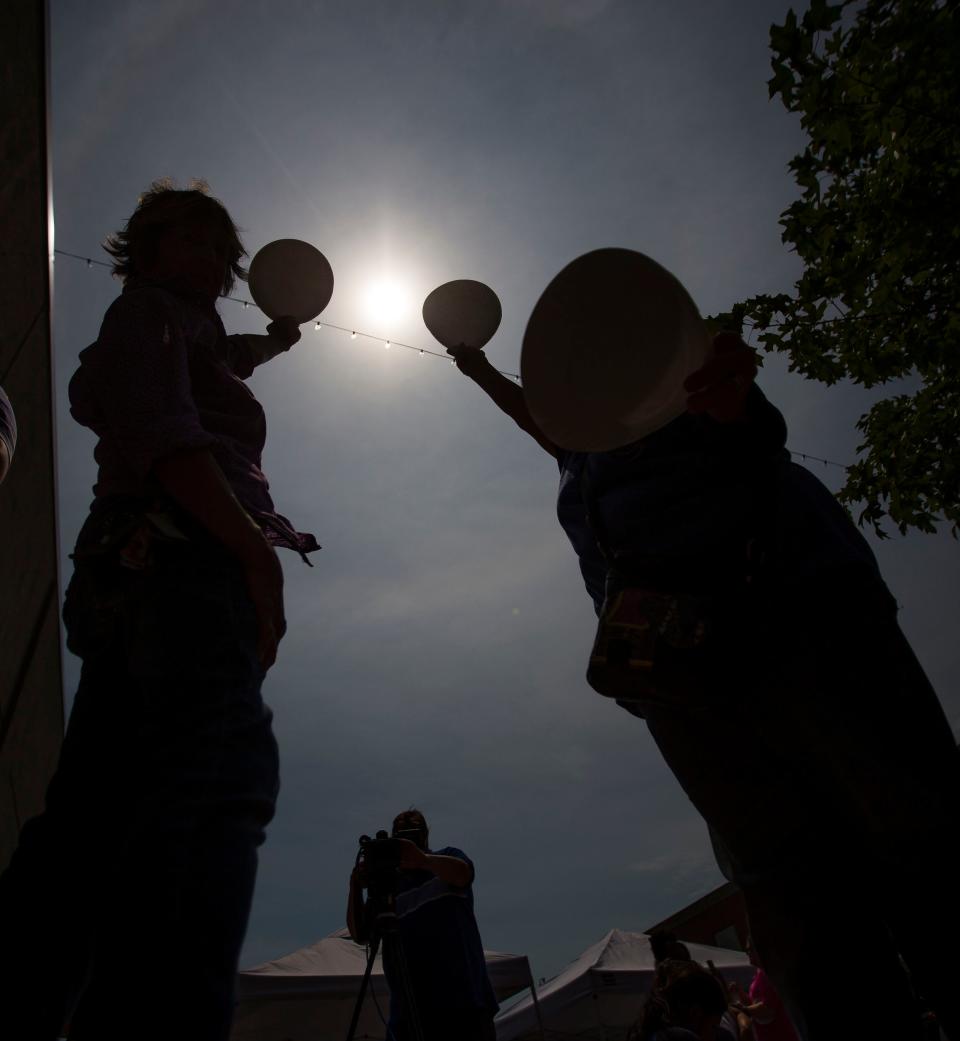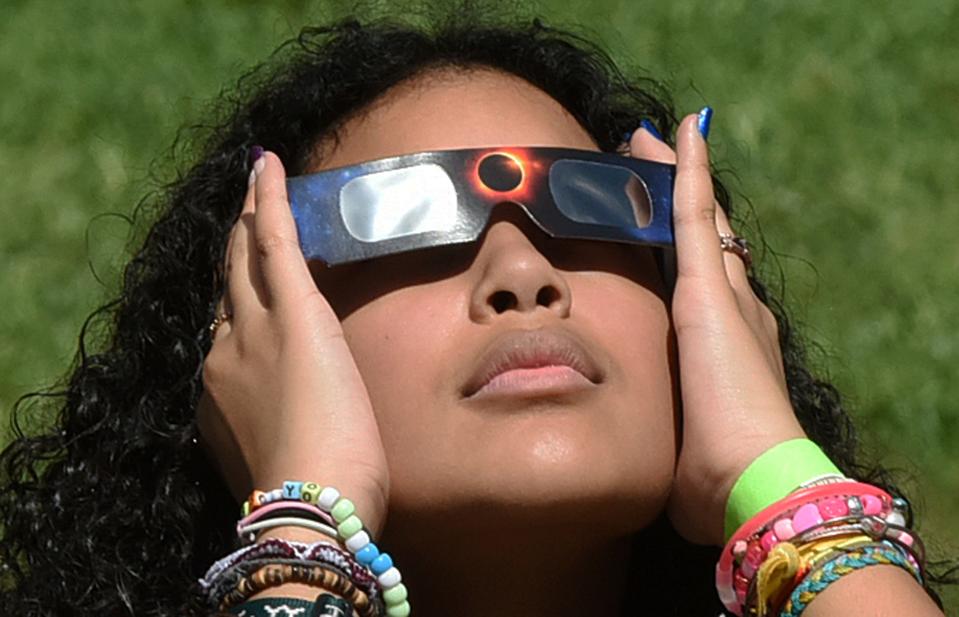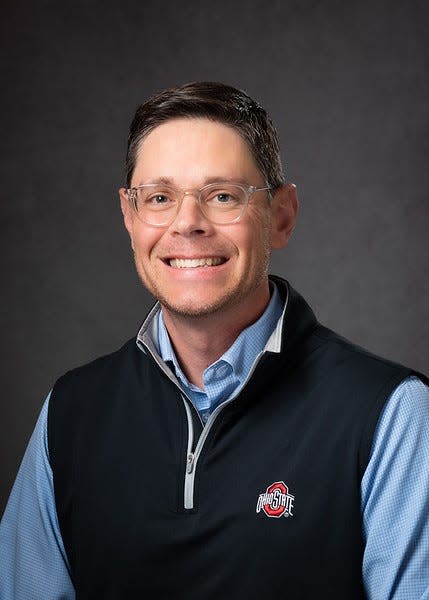Solar eclipse 2024: Why what you do now to prepare for April 8 can make all the difference
It’s been more than 200 years since Ohio was in the path of a total solar eclipse (1806), and it won’t happen again until 2099.
These are amazing events, not just because of the solar spectacle, but also because of the temperature change, the bird and animal sounds, and the unusual light on the horizon — it’s a total sensory event. So, it’s understandable that so many Ohioans are excited about April 8.
Spectacular and dangerous. How to safely enjoy 2024 solar eclipse.
Truth be told, we’re quite excited ourselves. As health professionals, though, we also have some concerns. The Central Ohio Hospital Council brought us together recently to talk about it, and from that conversation, we offer our top four tips to safely get the most out of this marvelous event.
Where to get free solar eclipse glasses

We know you’ve heard this many times, but it must be said often and strongly: do not look at the sun on April 8 (or any other day, for that matter) without certified glasses.
That is, glasses that meet the International Organization for Standardization for direct solar viewing.
Many libraries (the Columbus Metropolitan Library included) and schools are giving them away for free, but you can also buy them cheaply (less than $2 a pair) online or at local stores.
More: You need a special pair of glasses to watch the solar eclipse: How to get them in Columbus
Certified glasses have the ISO 12312-2 labeling clearly printed on them or in the description. The American Astronomical Society website has a long list of approved vendors (see below).
What if you already have solar eclipse glasses?
Older eclipse glasses, such as those from the 2017 partial eclipse, are okay to use if the lenses aren’t scratched, torn or punctured in any way.
The strongest sunglasses you own are not strong enough; eclipse glasses are many times stronger. Looking at the sun through cameras, telescopes or binoculars is even more dangerous, so don’t use them unless there are certified solar filters on each device.
It only takes a few seconds of looking at the sun to permanently injure the photo receptors on your retina.

The lens in the front of your eye focuses sunlight on the back of your eye in the same way a magnifying glass held between the sun and a piece of paper focuses the rays so strongly that it can start a fire. If you look directly at the sun without eclipse glass, damaging ultraviolet and infrared rays from the sun can permanently damage the inside of your eye through a chemical reaction called photo-oxidation.
Are you worried about the solar eclipse? April 8 event won't bring human sacrifice, but there are reasons for concern.
What are the dangers of not using the proper eclipse glasses?
Several central Ohio adults and children suffered permanent vision damage after looking at the sun without protection during the partial solar eclipse here in 2017.
Without proper protection, you could lose color perception, and experience blind spots and a big drop in your visual acuity for the rest of your life.
2024 total solar eclipse: Where to see it in Ohio and when it will happen
Even a few quick glances at the sun now-and-then will also cause damage. Since the full duration of the eclipse will be at least three hours in Ohio, three-or-four second glances taken every few minutes will quickly add up to more than enough exposure to damage your vision.
Bottom line: this is a rare and exciting event that can be easily enjoyed. Just wear ISO-certified glasses when looking at the sun.
Keep an eye on children during the eclipse
One of the unique features of this eclipse is that it takes place between 2 p.m. and 4:30 p.m. in Ohio, when schools typically dismiss and many children are outside and less supervised than usual.
Their natural curiosity will make them want to look at the sun, and it’s every adult’s responsibility to try to prevent this from happening if they don’t have the necessary glasses.

Fortunately, many Ohio schools in the path of the eclipse are closing early or planning distance learning on April 8. A list can be found on Dispatch.com.
Solar eclipse 2024: What central Ohio schools are canceling classes
Young children, especially, should be supervised.
If a child understands the danger of boiling water on a stove and knows not to reach for it, the child also should be able to understand the dangers of injuring their eyes by looking at the sun. Nevertheless, be sure to discuss these dangers with children and equip them with certified glasses if they’ll be outside during the eclipse. Because the eclipse unfolds over a three-hour period, children won’t be spending every minute looking at the sun.
The ISO-certified glasses are too dark to play in or to wear when walking or participating in other activities, but whenever they look at the sun, they must use the glasses.
The eclipse can be wonderful and enjoyable for children, and you should encourage them to see it, but only if they wear their glasses every time they look at the sun.

Be careful driving during the April 8 solar eclipse
It’s not a concern that most people think of, but Ohio’s expecting an influx of between 100,000 and 500,000 visitors from other states on April 8. They, and thousands of citizens from southern and eastern parts of our state, are expected to converge on the areas that will experience partial and total darkness.
States in the path of past solar eclipses saw major traffic congestion and more than the usual number of traffic accidents and distracted-driver incidents in the days before, during and after the event. In Ohio counties where the eclipse will be viewable, public officials and hospital emergency departments, including ours in Franklin County (in partial totality), are preparing for the same.

If you’re in one of the full or partial totality counties (see the map on the Ohio Emergency Management website; link below), our advice is to stay home between noon and 5 p.m. on April 8. Run your errands early in the day or, better yet, in the days before. Traffic in totality areas – even partial totality – will be busy, and drivers will be distracted, especially between 3 p.m. and 4 p.m. on April 8.
Total solar eclipse in Ohio in 2024: Public events and camping options for the big day
If you plan to drive to an event, plan to arrive early and stay late to reduce your time sitting in traffic. Don’t wear eclipse glasses while driving; you can’t see much while wearing them. That’s a good thing when looking at the sun; not so for driving and other activities.
Stay alert in crowds on eclipse day
There are many large gatherings planned in central Ohio and throughout the state on eclipse day.
If you’ll be at one, keep a close eye on children and pets and be sure they have identification on them. This will be at least a 3-or-4-hour event. Arrive early and take enough sunscreen, bug spray, water and snacks. Dress for the weather.
If it’s a private event, watch out for people drinking alcohol or using mind-altering substances. Their judgment will be impaired, and they may attempt risky behavior, including staring at the sun without protection.
There will be a lot of down time over the length of the eclipse, so plan how you’ll occupy your time, and know that you won’t be wearing your ISO-certified glasses every minute. Keep this in mind, if you too plan to partake.
As health professionals, we advise you not to, especially if you’re with children.

As for us, we’re planning to experience this event with family, friends, or co-workers, and we have our viewing glasses ready. Several of us have seen total solar eclipses in other parts of the country, and they were amazing.
If you can’t get outside to see it, or you would rather watch it in the comfort of your home, tune in to NASA’s live telecast online at plus.nasa.gov starting at 1 p.m. April 8.
We hope you enjoy every minute, and we wish all of you clear skies on April 8.
![ER physician Ryan Squier, who started the Ohio ACEP Opiate Awareness Team aimed at ending opiate abuse through education, poses for a portrait on Wednesday, July 11, 2018, in the Grant Hospital emergency department. [Fred Squillante/Dispatch]](https://s.yimg.com/ny/api/res/1.2/Q0QFfh7USrIMdewlRvU0Zw--/YXBwaWQ9aGlnaGxhbmRlcjt3PTY0MDtoPTg0MA--/https://media.zenfs.com/en/the-columbus-dispatch/03407ce9d68790814c06b52c2bb592b4)
Where to find more information
Ohio Emergency Management: ema.ohio.gov. Ohio’s main information and reference website for the 2024 eclipse. Learn about the path of the eclipse through Ohio, get safety and planning advice, as well as links to other organizations involved in eclipse activities, parking dos and don’ts, and more.
American Astronomical Society: Find numerous features here, including a list of approved vendors for eclipse glasses on the Eye Safety page. Remember, these glasses are absolutely necessary if you look directly at the sun. Get yours free at a local library or order them from a reputable vendor now! Don’t delay. See eclipse.aas.org/eclipse-america-2024
NASA Plus Live Telecast: If it’s cloudy where you are, or you can’t get outside, watch the eclipse online thanks to NASA satellites and land centers. Watch at plus.nasa.gov starting at 1 p.m.
Dr. David Rogers is chief of Nationwide Children’s Hospital's Department of Pediatric Ophthalmology. Dr. Julia Stokes is a Mount Carmel Medical Group Grove City Family Health family practice physician. Dr. Ryan Squier is associate medical director at the OhioHealth New Albany Emergency Department. Dr. Aaron Zimmerman is a clinical professor at the Ohio State University College of Optometry.
This article originally appeared on The Columbus Dispatch: Solar eclipse 2024 warning: How to safely enjoy

